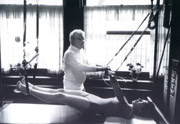|
|
History of Pilates
During World War I, Joseph Pilates, a German national of
Greek descent, was interned in England, where he trained
police officers beginning in 1912. A trained nurse in his
native Germany, he was investigating ways that he could
rehabilitate bed-ridden victims of the 1918 influenza
pandemic. Thus he created a series of movements that could
be practiced within the confines of this controlled
environment. The Pilates Reformer (a piece of Pilates
equipment) is based on an old hospital bed.
 Instead of performing many repetitions of each exercise,
Pilates preferred fewer, more precise movements, requiring
control and form. He designed more than 500 specific
exercises. The most frequent form, called "matwork,"
involves a series of calisthenic motions performed without
weight or apparatus on a padded mat. He believed that mental
health and physical health were essential to one another.
Pilates created what is claimed to be a method of total body
conditioning that emphasizes proper alignment, centering,
concentration, control, precision, breathing, and flowing
movement (The Pilates Principles) that results in increased
flexibility, strength, muscle tone, body awareness, energy,
and improved mental concentration. Pilates also designed
five major pieces of unique exercise equipment that he
claimed should be used for best results. Although the two
components are often taught separately now, the method was
always meant to combine both matwork and equipment
exercises. In all forms, the "powerhouse" (abdomen, lower
back, and buttocks) is supported and strengthened, enabling
the rest of the body to move freely. Instead of performing many repetitions of each exercise,
Pilates preferred fewer, more precise movements, requiring
control and form. He designed more than 500 specific
exercises. The most frequent form, called "matwork,"
involves a series of calisthenic motions performed without
weight or apparatus on a padded mat. He believed that mental
health and physical health were essential to one another.
Pilates created what is claimed to be a method of total body
conditioning that emphasizes proper alignment, centering,
concentration, control, precision, breathing, and flowing
movement (The Pilates Principles) that results in increased
flexibility, strength, muscle tone, body awareness, energy,
and improved mental concentration. Pilates also designed
five major pieces of unique exercise equipment that he
claimed should be used for best results. Although the two
components are often taught separately now, the method was
always meant to combine both matwork and equipment
exercises. In all forms, the "powerhouse" (abdomen, lower
back, and buttocks) is supported and strengthened, enabling
the rest of the body to move freely.
Pilates practitioners use their own bodies as weights in
training, to build strength, and flexibility. This is
targeted without a focus on high-powered cardiovascular
exercise. Today, Pilates is used in the rehabilitation
process by many physical therapists. Pilates is an old
approach to movement re-education that is becoming popular
in the field of fitness and rehabilitation. The Pilates
environment can be used as an assistive environment that
optimizes the acquisition of movement with a reduction of
destructive forces and can be used to progress individuals
through more challenging movements that represent their
day-to-day activities. Pilates' focus on building core
muscles and postural awareness are especially well indicated
for the alleviation and prevention of back pain. Research
and theories in motor learning, biomechanics, and
musculoskeletal physiology help support the phenomena
experienced by many Pilates-based practitioners; however,
the Pilates-based approach needs to be subjected to the
rigors of research to better evaluate its efficacy in the
field of rehabilitation.
In recent years, many Pilates students have seen important
parallels with the Alexander Technique, and the discoveries
of F. Matthias Alexander. Pilates has been used to train
dancers in flexibility and physical strength. The first
official Pilates Studio was opened in New York in 1926. In
recent years it has become a popular fitness modality, with
many stars attributing their successful weight loss and
increased muscle tone to Pilates.
In more recent years Pilates has been the subject of peer
review research articles and is now gaining acceptance
amongst the medical profession, even for conditions
previously contra-indicated such as pregnancy. Adi Balogh
wrote a substantial review article in the Journal of the
Royal College of Midwives.
|
|